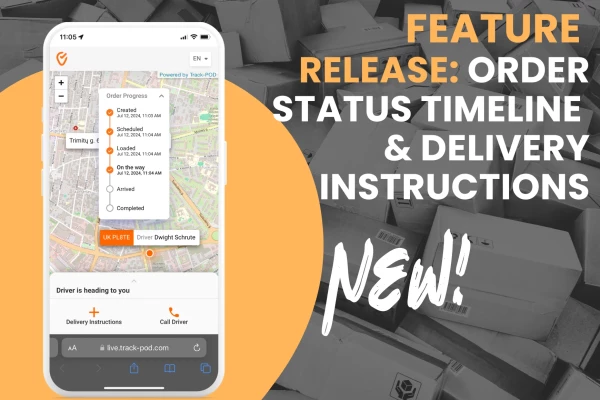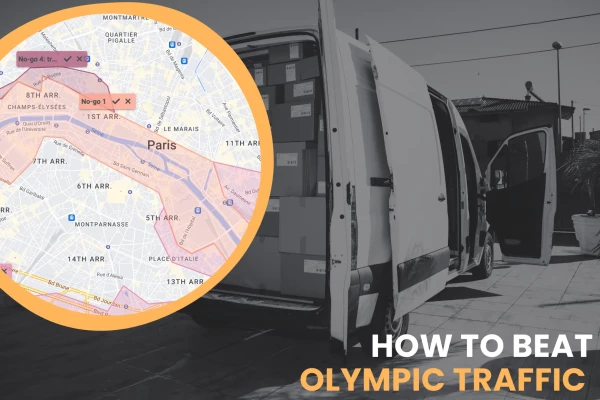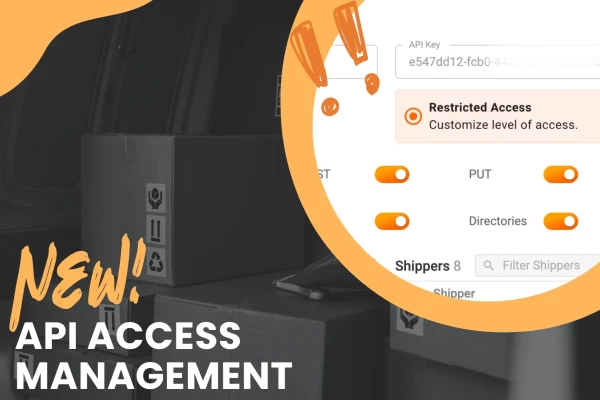How GPS Tracking Works: Guide for Delivery Ops

by
Yulia Miashkova
May 26, 2021
GPS tracking is used all the time, all over the world. We all have this technology in our phones and cars. It’s become an important part of everyday life. When it comes to logistics management, GPS technology is essential.
GPS route planning software makes up a vital part of any delivery or logistics business. It is used to help track mobile vehicles, plan efficient routes, avoid traffic, and gather important data for assessing various delivery metrics. Without GPS technology, logistics managers would struggle to keep their operations effective and profitable.
Wondering how GPS tracking works? We will explore this in more detail below.
What exactly is GPS?
Before we look into the specifics of how GPS tracking works, let’s just gain a quick understanding of this technology. GPS stands for Global Positioning System. GPS technology started in 1989 when the US Military launched a network of GPS satellites to orbit the earth. There are currently around 31 GPS satellites in this network.
The satellites transmit a signal down to earth which is used for GPS technology to understand positioning. These satellites transmit two signals: one for the use of the satellite constellation, and one signal that anyone with the right technical knowledge and tools can access. Because of this freely accessible signal, GPS manufacturers are able to create a wide range of GPS products.
How GPS tracking works
Now, let’s take a look at how GPS tracking works. The satellites in the GPS constellation transmit a signal to GPS receivers on the earth. The communication of this signal is able to determine the exact position of the receiver. These signals are being constantly communicated.
When the receiver on earth picks up a signal from a satellite, it measures how long it took to receive the signal, and it uses an atomic clock to compare this time with the position of the satellite. Remember, the satellites are constantly in motion.
So, the GPS device will pick up signals from different satellites. A process called trilateration, which uses the signal from three different satellites, is then used to determine the exact position of the device in relation to the earth. The GPS device knows the position of these satellites and measures how long it took to receive their signal. It also considers their trajectory.
With the knowledge of where the satellites are in relation to the earth, the device can determine its own position. This position is then measured through a set of coordinates.
The process of how GPS tracking works is actually pretty simple. It’s also incredibly accurate. The satellites are in an orbit that is specifically planned out so that there should be around four satellites available for any specific area of the earth. If there are more satellites available, the exact positioning can be even further refined and made more precise. Just about any place on earth will be able to communicate with GPS signals and receive an accurate positioning reading.
What delivery managers need to know about GPS tracking
Now that you know how GPS tracking works, you may be wondering how it relates to logistics managers. GPS route software is undeniably one of the most valuable pieces of technology for any logistics business. Logistics managers rely heavily on GPS technology for a wide range of their regular business functions.
Of course, the main reasons for using GPS are to plan out delivery routes and visibly track the delivery vehicles. GPS for truck drivers lets them know exactly which route to take without getting lost, and it allows for accurate, real-time visualization of where these vehicles are.
Your GPS route system can do quite a lot more than just this. Logistics managers can use their GPS to access valuable data. This data offers endless possibilities for logistics businesses to improve their efficiency and optimize their processes.

Information can include things like tracking delivery driving speeds and idling times, hours worked, fuel consumption relative to delivery routes, and so on. All of this data can be used to create useful reporting for a logistics business.
So, as a logistics manager, your GPS offers you many of the tools you need to effectively manage your fleet and your operations. From route planning to efficient delivery management, your GPS software is essential for smooth logistics management.
Benefits of GPS tracking
Beyond understanding how GPS tracking works, you should understand all of the benefits that this technology actually offers. We have highlighted some of the main advantages of using GPS for truck drivers and logistics managers below.
Save time on delivery routes
When you use GPS route planning software, you don’t only get positioning on the route, but you can also access valuable information on the route – such as traffic. Traffic on delivery routes wastes time which affects your profits.
GPS tracking can be used by logistics managers to identify traffic holdups and quickly reroute the delivery. This saves valuable time on the delivery route, and rerouting can be done instantly.
Become more organized
Using GPS route planning technology helps logistics managers streamline their operations. The technology offers a better platform for fleet managers to make faster, smarter decisions on delivery routes and dispatches. This increases coordination throughout the daily delivery schedule – something that also enhances productivity.
Optimize delivery routes
One of the main benefits of using GPS technology for logistics managers is optimized routes that boost productivity and decrease downtime. Delivery management software can use smart GPS functioning to map out routes that offer the highest level of productivity in the shortest amount of time. This means being able to execute more deliveries in a shorter amount of time – saving money and supporting operations.
Provide a better customer experience
GPS route software doesn’t only enhance organization for delivery operations. It also improves the customer experience. Customers want the opportunity to track their orders and want to be kept up to date on the delivery progress. With the right delivery management software, customers can track their delivery orders on a map in real-time. This improves customer communications and meets their expectations.
Delivery companies can provide the exact location of each order to the customer. If any customers have questions about their delivery status, the delivery company can use the GPS route to offer an instant update on the whereabouts of their order and estimated time of arrival (ETA).
Access useful data and analytics
If you want to enhance your logistics management, you will need to have a clear set of accurate data to create reports and gain useful insights. Once you know how GPS tracking works and how to utilize it, you can use the technology to create accurate analytics reports on your delivery operations.
You have access to data on how quickly deliveries take place, which routes are best, fuel consumption compared to delivery routes, driver performance, and so on. Logistics managers can use this data to analyze their operations and make more informed decisions on how to create improvements.
Improve navigation and communication
Probably the most obvious advantage of using GPS for truck drivers is that it makes navigation so much easier. Drivers are able to access a clear route that they can follow, reducing the risk of getting lost or deviating from the originally planned route.
This makes navigation easier, but it also improves communication between the truck driver and HQ. If a sudden change needs to be made in a delivery route, the driver can be instantly updated through their GPS. This keeps logistics managers and truck drivers on the same page at all times.
Run safer deliveries
GPS tracking also helps improve the safety of delivery routes. This is because smarter routes can be planned out to better suit the exact specifications of each vehicle. GPS for truck drivers makes it easier for drivers to navigate clear routes and focus on the road.
GPS technology can also be used to access valuable information on each driver’s habits in relation to their delivery routes. This can help logistics managers improve driver training and correct any bad driving habits that come up.
Get better insurance rates
Since vehicles are safer with GPS tracking due to better and more efficient routes, insurance companies often offer better rates to businesses that utilize this software. This is also because logistics managers are able to keep better track of each vehicle which decreases the risks around them. Vehicles that are better supervised are also more protected against theft.
Cut fuel costs
Fuel is one of the biggest expenses for any delivery business. GPS tracking allows logistics managers to keep an eye on vehicle performance and fuel consumption. GPS can be used to monitor the vehicle’s speed which is something that affects the overall fuel consumption. The technology is also used to optimize routes, cutting down on unnecessary driving.
As I have already mentioned, GPS can save delivery companies plenty of time on their routes, improving operational efficiency. This is also necessary for saving fuel.

Manage drivers better
Before logistics businesses started using GPS tracking, a driver and vehicle would leave the warehouse at the start of the day, and return at the end of the day. The only way to track the vehicle and its movements was to get manual updates from the driver, which could be unreliable.
With GPS tracking, logistics managers are able to keep tabs on all delivery drivers and vehicles at all times. This cuts out the driver’s ability to do side jobs or personal errands. With GPS tracking, logistics businesses get the job done, making sure that only authorized jobs are being performed.
Save money on delivery operations
GPS tracking will help any business save money and boost its profits. All of the advantages listed above help maximize efficiency and operational accuracy. Saving time and increasing the rate of successful deliveries can cut down costs dramatically, increasing a logistics company’s profits. The ROI for GPS tracking can be really significant.
GPS tracking cons
Although GPS tracking offers a clear set of advantages to any logistics manager, there are still reasons that some logistics companies are not completely sold on the technology. Some people consider the introduction of GPS technology an invasion of privacy. The constant monitoring and tracking of vehicles have caused some drivers to feel distrusted.
This is a misconception though, as these drivers may not realize the actual value that GPS tracking offers. The technology is not just there for a monitoring function, but it is there to enhance general business operations.
Logistic managers can help drivers get past this misconception by offering rewards that GPS tracking can monitor. For example, driver performance can be monitored on a far greater scale. Logistics managers can use the performance metrics that the GPS offers to set rewardable goals for high-performing drivers.
Finding the right GPS tracking software for your logistics business
GPS technology is seen in all kinds of apps and devices. Choosing the right option for your business is important if you really want to make the most of the technology to optimize performance. Logistics managers should look for a complete delivery management software suite that uses GPS to enhance a variety of functions.
The software should offer route optimization, vehicle management, communication advantages, instant notifications, as well as a GPS tracking solution for customers. Using a delivery management solution like Track-POD will give your logistics business a single software option that can be used to enhance multiple functions.
Conclusion
Knowing how GPS tracking works, and how it can enhance your operations, is important for any logistics manager. This is an essential piece of technology for better logistics management and improved productivity. GPS tracking software can save businesses plenty of money while boosting their daily performance.
GPS tracking can be a fairly simple idea. However, the right delivery tracking software uses GPS for many valuable insights and functions. Something as simple as being able to track a vehicle opens up a huge range of possibilities and advantages for businesses to make use of.
If your logistics business is not making the most of GPS tracking, then it’s time to choose the right delivery management software. It will make a huge difference.
About The Author
Yulia Miashkova
Growth marketing manager with a background in public relations, SEO, social listening, and Account-Based Marketing.





